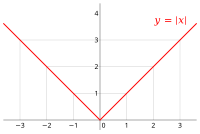Absolute value

Absolute value is a way to figure out how far away a number is from zero, without caring whether the number is positive or negative.
Imagine you're playing a game with your friends where you're all standing on a number line. Some of your friends go to negative numbers (like -3), while others go to positive numbers (like 2). When it's your turn, you want to know how far away you are from the number 0, which is right in the middle of the game board.
So, you look at your number and you see that it's -2. But you don't want to count the negative sign, because all you care about is how far away you are from 0. You can think of this as taking the number and flipping it over so that it's now positive. This is what absolute value does - it just gets rid of the negative sign so you can focus on how far away a number is from zero.
So, the absolute value of -2 is just 2, because that's how far away -2 is from 0 on the number line. And, the absolute value of 3 is also just 3, because that's how far away 3 is from 0.
Overall, absolute value is just a way to figure out the distance between a number and 0, without worrying about whether the number is positive or negative.
Imagine you're playing a game with your friends where you're all standing on a number line. Some of your friends go to negative numbers (like -3), while others go to positive numbers (like 2). When it's your turn, you want to know how far away you are from the number 0, which is right in the middle of the game board.
So, you look at your number and you see that it's -2. But you don't want to count the negative sign, because all you care about is how far away you are from 0. You can think of this as taking the number and flipping it over so that it's now positive. This is what absolute value does - it just gets rid of the negative sign so you can focus on how far away a number is from zero.
So, the absolute value of -2 is just 2, because that's how far away -2 is from 0 on the number line. And, the absolute value of 3 is also just 3, because that's how far away 3 is from 0.
Overall, absolute value is just a way to figure out the distance between a number and 0, without worrying about whether the number is positive or negative.
Related topics others have asked about:
